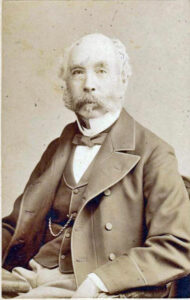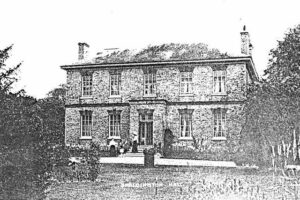It is only a few days before Easter but it is still cold and wet and however much I want to get out into the garden it is impossible as everywhere is soggy. I am hoping to start various seeds in the greenhouse but enthusiasm is hard to find when the weather is so horrible.
But local history is always there and I have been interested to follow the work of the Howdenshire Archaeological Society //www.howdenshire-arch.org who are working on the history and archaeology of Spaldington. Do visit their website and facebook page to see what they have found so far and what their plans are.
Many years ago I knew a gentleman called Bill Atkinson who, long before the days of the internet. made a study of the village. His work is invaluable today.
My memories of Spaldington centre on visiting a shop/emporium/ shed in the village run by a gentleman called Brian Terry. My father often took my brother and myself there where you could buy all sorts ranging from tools, nails, paint etc to wellingtons, torches and shoelaces - in fact almost anything. Of course he is long gone but I can still remember the varied contents and characteristic smell of his premises.
Over the years I have researched different aspects of the village. The early history is very interesting - the land passing from the de la Hay family to the Vavasours but the family story I wanted to mention today is what happened after the last maleVavasour heir of Spaldington died. It is a a bit complicated! Below is a shortened summary.
Thomas Vavasour 1636- 1679
Thomas was the last male heir of the Spaldington Vavasour family. He died in 1679 aged 43 and was buried at Bubwith.
The Trafford connection
Thomas' daughter and heir, Mary Vavasour, married Sir Ralph Assheton of Middleton, Lancs,
Their eldest daughter Anne, married Humphrey Trafford, Esq on 5th Aug 1701, in Manchester. [This is the same family who have given their name to several modern features - eg Old Trafford and the Trafford Centre]
Humphrey and Anne had a daughter, Elizabeth Trafford, who married Mail Yates, of Mail, Lancashire, and who had three daughters: Anne Assheton Yates, Mary Yates who married Henry Aspinall and Catherine Yates who married Robert Campbell.
The three sisters
On the death of Elizabeth in 1788 the ownership of Spaldington was split into three parts.
1. Anne Assheton Yates married Henry Nooth, a Colonel in a Cavalry Regiment, who took on his marriage the name of Vavasour in 1791, and was created a baronet in 1801. He died in 1813 at Melbourne Hall [Yorkshire]. His widow, the former Anne Asheton Yates, died in York in 1818 aged 88.
Their eldest son, born in Dorset in 1768 was Henry Maghull Mervyn Vavasour [born Nooth] who was a career soldier. He died at Melbourne Hall in 1838 and was buried at Bubwith. His son Henry Mervyn born 1814 died aged 98 in 1912.
This is a picture of Henry M Vavasour taken in 1890
2. Mary Yates
Mary married lawyer Henry Aspinall . She died in 1794 and he inherited her third of Spaldington which included the hall and much of the land north of the village. He put it up for sale in 1809 and died in 1810.
Lord Howden
In May 1809 the following advertisement appeared in the Hull Advertiser
FREEHOLD ESTATE, consisting of the Spacious MANSION HOUSE, called SPALDINGTON HALL, and several FARMHOUSES, with suitable OUTBUILDINGS, and 966 acres. of Fertile LAND, in a ring fence, divided into convenient Farms. Also, ONE-THIRD part of the MANOR of SPALDINGTON.
It was bought by eminent soldier General Sir John Francis Cradock who also bought Grimston Hall. In 1819 he was granted the Irish title of Baron Howden of Grimston and Spaldington. He was the only son of John Cradock, formerly Archbishop of Dublin and Primate of Ireland.
So in 1822 we read that 'The hall at this place was formerly the seat of the ancient and honourable family of Vavasour, but now the property of Lord Howden, it exhibits a fine specimen of architecture of the time of Queen Elizabeth. "
Baron Howden was granted the English title in 1831. He died in 1839 and was succeeded in the title of Lord Howden by his son, John Hobart Cradock who immediately remodeled Grimston Park as an "Italianate palace" with large pleasure grounds and a riding school.
But Lord Howden and his wife divorced and the estate including Spaldington was sold in 1851 to fellow diplomat Albert Denison, 1st Baron Londesborough.
For example a newspaper report of 1822 reports a death at Stanton, near Burton-upon- Trent, Staffordshire, at an advanced age, Wm. Nadin, Esq. formerly of Spaldington Hall, and father of the late Mrs. Waterworth, of Wressle Castle
Demolition
Whilst under the ownership of Lord Howden the old Elizabethan hall was pulled down in 1838. It was replaced by a new building within two years which is now known as Old Hall Farm.
In 1845 Old Hall farm was occupied by Thomas Stogdale who was renting from Lord Howden. He was farming 300 acres and employing 4 labourers in 1851. He was married to Ellen and they had two sons.
Catherine Eleanor married Robert Campbell of Arknish House in Argyll and had two daughters Catherine and Sarah Charlotte. She was the owner and probably the builder of a new hall at Spaldington which was on her property, south of the old hall. One source suggests it was built in 1810, the year Lord Howden bought the old hall.
With Immediate Possession, with or without TWELVE ACRES of GRASS LAND, a very desirable RESIDENCE, comprising Drawing, Dining, and Breakfast Rooms, with suitable Lodging Apartments; also, Butler's Pantry, Coach House, Stables etc. There is also a large Orchard, and an excellent Kitchen Garden.
Catherine died in 1838, the same year as her her daughter Catherine and her sister's son Henry M M Vavasour who died at Melbourne. Also of course this was the year too that the Old Hall was pulled down.
Her surviving daughter Sarah Charlotte inherited her Spaldington property and on the tithe award of 1849 is shown as owning and occupying the house. She had married Nathaniel Jekyll of Pitcombe House in Somerset but after he died she sold up in 1830. In 1838 she was given official permission to be known solely by the surname Campbell.
She died in 1853 at Bath and left her Spaldington property to her cousin Henry Mervyn Vavasour. She left a bequest to create a charity for the poor who lived on her lands.
In 1857 it was described as 'The present hall, the property of Sir H. M. Vavasour, and residence of Robert Goldthorp, Esq., is a large brick building, with stone dressings, erected in 1810'.
In 1857 it was described as 'The present hall, the property of Sir H. M. Vavasour, and residence of Robert Goldthorp, Esq., is a large brick building, with stone dressings, erected in 1810'.
Robert Goldthorpe did not live in the house for very long but seems to have made a good impression.
We read that in 1856 — R. Goldthorpe, Esq., of Spaldington House, has lately distributed to each widow, and to the deserving poor of Spaldington, a pair of blankets, as a Christmas-box. At this inclement season, nothing could have been more suitable. During the past year this respected gentleman presented a very handsome Bible and prayer book for the use of the established Church in Spaldington. Other charitable and local projects have met with his liberal aid and support. May he long live to enjoy the hearty good wishes of the poor and all who have the pleasure of knowing him.
He was a widower and when he remarried in 1863 he left the district, moving to Surrey where he died in 1870.
THE SPALDINGTON ESTATE, including the Mansion known as Spaldington Hall, with its Gardens and Pleasure Grounds, surrounded by a Freehold Domain of 2,510 acres of superior land, divided into 12 capital farms, interspersed with woodlands and plantations affording coverts for game, lying in a ring fence, only two miles from the Howden Railway Station, within an easy distance of the city of York, and being in a thoroughly rural district, yet of easy access from the manufacturing towns of the West Riding, particularly eligible as a residence or investment for a banker, merchant, or country gentleman.
Spaldington Hall, a modern-built residence in grey brick, with stone dressings, and slated, is pleasantly situated, overlooking an enclosure of park- like pasture, and is approached by an entrance lodge and carriage drive through ornamental plantations, lawn, and pleasure grounds ; it contains an entrance-hall, dining, drawing, and breakfast rooms, seven bed rooms and dressing rooms on the first floor, besides attics, housekeeper's room, ample domestic offices, stabling, etc.
On another part of the estate a second residence has recently been erected, in the Gothic style, and large sums have been expended in the erection and repair of the farmhouses, homesteads, cottages, and the buildings generally are of a most superior character, and in excellent order.
The Estate comprises 2,540 acres, of which about 800 are fine pasture lands and orchards, 50 acres woodland, and the remainder arable. The soil is a strong, deep loam, and tbe portions requiring it having been under-drained in the most effective manner under Government Inspection, it is capable of producing very large crop of both grain and roots, while the size and regularity of the enclosures render it especially suited for steam cultivation, and it is most accessible to good markets, the roads and river Ouse affording every facility for the delivery of produce. Deep seams of coal exist under the whole of thia district, though at present unworked. The compact character of this Estate is favourable for the preservation of game. It is at present well stocked with partridges and hares, and has excellent covert for pheasants. The country is hunted by the Holderness and York and Ainsty hounds, and good trout fishing may be had in the vicinity.
The farms included Fir Tree House [described above as newly erected], Town End Farm, Sandwood House Farm, Yoke Gate Farm, Sykes Farm, Warham Farm.
So next time you hear of Old Trafford or visit the Trafford Centre remember the connection with our small East Yorkshire village of Spaldington.


William Nadin Esq had a son called Humphrey Trafford Nadin, born in Spaldington in 1782, suggesting a family connection. His daughter Ann died in 1810 at Wressle Castle. Mary Waterworth (1728-1800) later Mary Watson of Hagthorpe is my 5th great Grandmother.
ReplyDeleteIn fact, William Nadin was the Steward of Spaldington Hall and marries Ann Guy, daughter of Marmaduke Guy who had family connections to the Wilberfosses.
ReplyDelete